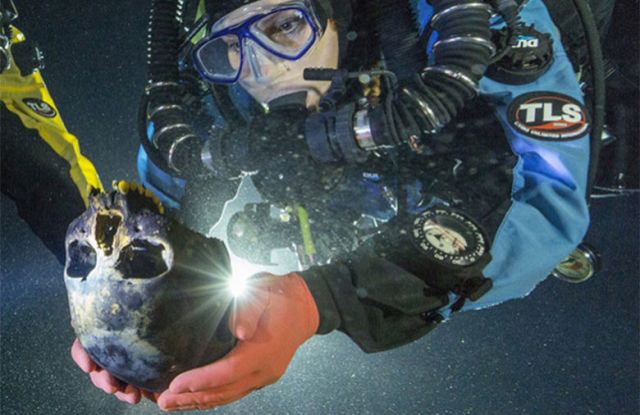Have you ever wondered how long people have inhabited the Americas for? I don't know about you, but it's the kind of question that keeps me up at 3 AM.
It seems that new archaeological discoveries keep on pushing the date back for oldest permanent settlement in the Americas. For a long time, a discovery at Clovis, New Mexico in 1932 caused people to agree that the earliest settlements in the Western Hemisphere were established around 13,000 years ago. In 2011 however, the Buttermilk Creek complex in Salado, Texas was discovered. This paleolithic settlement was found to be 15,500 years old.
These incredible discoveries were not only made in the southern United States. On Triquet Island, just off the coast of British Columbia and north of Vancouver Island, a 14,000 year old village was excavated in 2017.
Alright, so we know that the first settlements in the Americas were way older than 13,000 years.
Some people may wonder, were the people who lived in these paleolithic settlements genetically related to modern Native Americans? I mean, our automatic assumption would be yes. But it was important to still find some concrete evidence to dispel any ridiculous pseudo-historical myths circulating about how these first inhabitants were the Lost Tribes of Israel or... Solutreans (yes there are actually some people who think Europeans from the Iberian peninsula crossed the Atlantic 26,000-19,000 years ago).
Crossed the Atlantic?
Some good sources for further reading:
If you want to read my rant about how much I hate pseudo-history, Check out this post I wrote back in 2017 . For now, lets focus on facts.
This next discovery is very important. In 2007 the 13,000 year old skull of a female teenager was found in an underwater cave in Mexico and was given the name "Naia" (a clever Greek mythology allusion). DNA tests were done on Naia, and from this it was concluded that the results matched with modern Native Americans. Well, that's just one example, but many other DNA tests from other parts of the continent have come up with the same conclusion. We need to stop denying Native Americans their ancient heritage. It's time to end racist and damaging pseudo-history. Here's a post I wrote a long time ago about the facial reconstruction of an Ancient Peruvian Queen that seemed somewhat relevant.
So for the remainder of this blog post, I'm going to continue pondering the questions when did the first people get here and how did they get here? Neither question has a definite answer, but it's fun to research the possibilities. Perhaps someday archaeology will uncover the truth.
3 million years ago, way before there were any people anywhere, an isthmus formed that connected North America and South America. This is everyone's favourite isthmus now, Panama.
During the recent Ice Age, about 1.8 million years ago, glacial advances covered up most of the northern extent of the continent. This caused worldwide sea levels to lower as water became locked in the ice sheets. So, vast amounts of land sprung up that are now submerged under higher water levels. One of these land masses was Doggerland, which connected northern Europe and the British Isles.
But everyone's favourite now-submerged landmass was of course Beringia.
Beringia Refugium
The theory goes that Beringia was a large shelf between Alaska and Siberia. It was nearly continent-sized. It also wasn't glaciated! This means that there were actually vast grasslands on Beringia capable of supporting herds of animals. This is what gave it the name "beringia refugium" as it was like a refuge for these creatures who could not survive in the glaciated areas. Lots of animals crossed over this land bridge, as well as people. These people migrated across Beringia at least 20,000 years ago and no earlier than 50,000 years ago.
Creatures of Beringia Refugium
- Ancestors of the modern horse, which would then go completely extinct until Europeans reintroduced horses.
- Ancestors of camels, which evolved into llamas.
- The longhorn bison
- Huge beavers
bEwArE!
The crossing of people across Beringia would have been a leisurely and slow one. People would have moved to follow the big game herds. As mentioned earlier, this crossing could have occurred any time after 50,000 years ago and probably before 25,000 years ago. That answers the very first question posed of how long Native Americans lived here, but how they got here still hasn't completely been answered.
Let me explain, of course the Bering Strait theory is the most credible theory we have and it has lots of scientific proof, but people have also suggested an alternate theory (or one that could have occured after Beringia): water craft.
If you don't think people 25,000 years ago could have invented water craft, think again because the Australian aboriginals got to Australia by boat 50,000 years ago from Africa.
But now there's a bit of a problem...
Because you see, we still don't know how people crossed into the interior of North America, beyond the glaciers. Some have suggested that a corridor opened between the glaciers originating in the Rocky Mountains and the ones from Hudson's Bay. Others have countered that and said that if a corridor really had opened up, the environment would be too harsh to allow crossing. So here the water craft theory comes in again.
Clearly, people need to look more into this so that these mysteries can be solved.
But some how, we know that indigenous people definitely spread as far as South America before 20,000 years ago. We can call this group the Paleo people as they migrated to the Americas during the last glacial episodes. By this time mass extinctions of all the weird animals I mentioned earlier started happening.
The Archaic Period
Around 9,500 years ago the Archaic Period began. Native people had to start adapting their way of life to a warmer environment. The Archaic Period ended around 2,900 years ago. Around 4000 years ago the Tuniit culture emerged from Greenland and spread across the North American Arctic region.
The Tuniit and the Thule
The Tuniit (also known as Paleo-eskimos although I'm not going to use that word because 'eskimo' is a derogatory term meaning 'eaters of raw meat') founded what is now known as the Dorset culture.
The Dorset culture produced many cool ivory carvings like this polar bear thing.
Unfortunately, the Tuniit were not that great at adapting to the changing environment. The summers were getting unusually warmer and that caused many changes in animal migration patterns. Their culture started to rapidly decline.
Meanwhile in Alaska, a highly mobile people who could travel in dogsled teams were having no problem at all and were flourishing. These were the Thule. The Thule eventually dominated the Arctic.
Here is a map that shows the Thule spreading all over Arctic Canada:
The Thule became the ancestors of the modern Inuit :)
So why does this all matter?
If you've actually read through all of this, you have probably already realized why this may be important. By recognizing that indigenous people have been here for at least 25,000 years, it gives their land claims even more legitimacy and confirms their oral traditions with scientific facts. Meanwhile, European settlers have only been here for around 500 years.
Alright folks, that's all. Stay tuned for more posts. I have an opinion piece and a book review coming up soon.
Some good sources for further reading:











No comments:
Post a Comment
Leave a comment